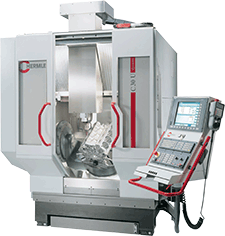- 01: Introduction
- 02: History
- 03: Propellants, Firearms, and Ammunition Development
- 04: Modern Firearms Manufacture
- 05: Small Arms Ammunition
- 06: Evidence Handling Procedures
- 07: Equipment and Instrumentation
- 08: Examination of Firearms
- 09: Cartridge and Shotshell Examination
- 10: Characterization and Evaluation of Fired Projectiles
- 11: Bullet Comparison and Identification
- 12: Gunshot Residue and Distance Determination
- 13: Toolmark Identification
- 14: Communicating Results
- Resources


Computer Numeric Control Machining
Home > Modern Firearms Manufacture > Fine Forming Operations > Computer Numeric Control Machining

CNC machining example
Click for larger imageComputer Numeric Control (CNC) machining has revolutionized manufacturing in many fields. CNC is a form of computer-aided manufacturing (CAM) that combines many processes (drilling, turning, milling, etc.) into one multifunction machine. Because the floor space (footprint) required for one CNC machine is a fraction of that required for multiple work stations, output is significantly increased without sacrificing quality.
CNC machining is best suited for mass production where many identical items are required. A CNC machining center requires minimal operator intervention for routine operation; one operator can manage several work centers simultaneously.
In CNC machining, a computer program describes the position of features (physical characteristics) to be machined. Typically, a reference point on the raw stock is identified as 0, 0, 0 in three-dimensional Cartesian coordinates. All other features are referenced from this starting point. The CNC machine has multiple tool holders and can choose the tool needed for producing a specific physical feature in the final work product. Advanced machines have tool storage magazines. The machine chooses the correct tool specified by the program instruction, installs it in a tool holder, and cuts the feature.

Click here to watch a CNC machine in operation
Once the program is completed, the machine may require an operator to install a new piece of raw stock and manually restart the process. Automated units perform without operator intervention. A stock feed system holds a supply of raw parts and the programmed input includes the total number of parts to be processed.
More advanced CNC devices incorporate CAD/CAM—computer-aided design/computer-aided manufacturing.
The process includes the following stages:
- The engineer or drafter draws the part required in three dimensions using drafting software; all dimensions that define the part are included.
- The drawing is sent directly to the CNC center where other software
- converts the common engineering dimensions to Cartesian coordinates,
- determines which cutting tools are needed,
- establishes the most efficient order of operations to produce the desired part.
With traditional manufacturing, the raw forging would go to one machine for initial shaping and then be passed to successive machines for additional machining. These machines take up floor space and require an operator. Each operator must remove the part from the set-up for measurement several times before it is ready to move to the next machining step. Fabricating the same part with CNC technology can be accomplished with one or two machines and a single operator. The cost savings are tremendous, and the quality of the part is better because human error in the downstream operations is virtually eliminated.




